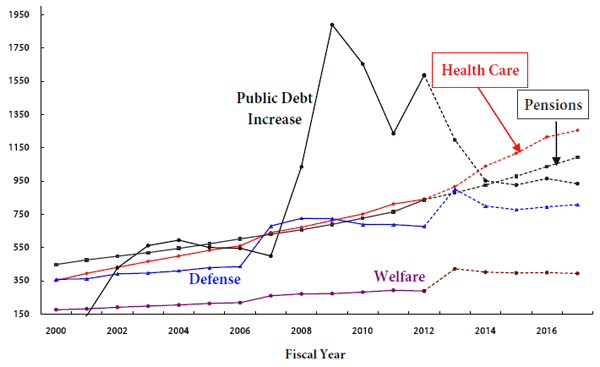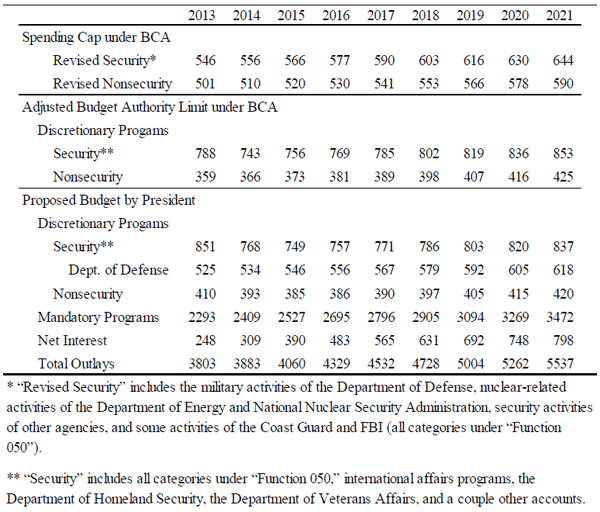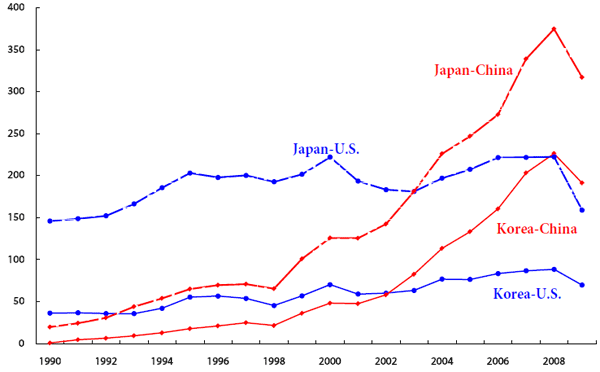
Aging Eagle and Dark Clouds on the Security Horizon
Commentary·Issue Briefing | 2012-10-10
Dong-Joon Jo
Dong-Joon Jo is a professor at the Department of Political Science and International Relations, Seoul National University.
Partisan Gunfire after the Financial Crisis
The financial crisis in 2008 exposed a latent weakness that the United States would not have resources enough to cope with its population aging and maintain its global leadership. The crisis led the federal government to increase its welfare spending, bail out faltering industries, and rely on measures of economic stimulation. These measures resulted in the swelling of the public debt, which increased by $5,077 billion from fiscal year 2006 to fiscal year 2010, and intensified the U.S. federal government’s budgetary difficulties in meeting the welfare and medical needs of senior citizens and carrying out the war on terror abroad (See Figure 1). The belief in the sustainability of the public debt severely weakened, as the interest expense on the public debt rose to 8.6 percent of the total federal spending in 2010; the belief in the comparability between U.S. domestic welfare and its global leadership eroded.
The financial crisis evoked a fairly routine set of behavior in partisan politics in 2011. When the public debt was about to reach the ceiling in 2011, Republicans and majority members of the Tea Party threatened not to agree on raising the debt ceiling. They pressured the Barack Obama administration to reduce the federal budget and governmental regulations. Meanwhile, the Obama administration and Democrats wanted to raise the maximum amount of governmental borrowing and keep boosting the economy. In the gunfire between the two parties loomed the possibility of sovereign default. Amid the partisan conflict the credit rating of the U.S. government bonds was downgraded for the first time in history; major market indexes plunged in the third quarter of 2011.
The Budget Control Act was the result of bipartisan negotiations, accommodating conflicting goals and instruments from both sides. It provided breathing room for the Obama administration and Democrats by allowing the debt ceiling to increase by $900 billion two times in 2011 and additionally by $1.2 trillion in 2012. Meanwhile, it reduced the budgetary leeway of the administration and gave more power to the House, where Republicans and Tea Party members held the majority. More specifically, it established binding limits on annual appropriations bills to reduce the funding for discretionary programs, relative to the funding in the Congressional Budget Office’s 2010 baseline; it set up a Joint Select Committee on Deficit Reduction, the “Supercommittee,” to come up with a bill to reduce deficits by at least $1.5 trillion through 2021. The legislation appeared to keep the partisan gunfire under control.
Figure 1. U.S. Federal Spending and Public Debt in the 2000s (billion U.S.$)

A Stray Bullet at the Defense Budget
The Budget Control Act has two conditional fail-safe mechanisms to make sure that the budget reduction should be at least $1.2 trillion from fiscal year 2013 through 2021: binding spending limits and a sequestration plan. If the Congress fails to enact any joint committee bill to reduce the federal budget by January 15, 2012. or the budget reduction under a joint committee bill is less than $1.2 trillion for nine fiscal years, discretionary programs will automatically come under spending limits (see Table 1) and a sequestration plan will be triggered to achieve the deficit reduction of $1.2 trillion. The two conditional mechanisms were intended to encourage the two parties to agree on the deficit reduction and to enact alternative legislation in case the bipartisan negotiations fail. If the fail-safe mechanisms were actually applied, the defense budget cut would be unacceptable to Republicans; the welfare budget cut would be unbearable to Democrats.
The amount of deficit reduction and its allocation is calculated as follows:
(1) starting with $1.2 trillion;
(2) subtracting the amount of the deficit reduction achieved by a joint committee bill (if none, no subtraction);
(3) reducing the above difference pursuant to (2) by 18 percent to account for debt service interest;
(4) dividing the result pursuant to (3) by 9;
(5) allocating half the amount pursuant to (4) to accounts within the defense function and the other half to accounts in nondefense functions.
The bipartisan negotiation in the joint committee failed to reach any agreement on the budget reduction. There was no alternative legislation to stop the two conditional mechanisms from being implemented. The negative consequences that the two conditional mechanisms would bring were not strong enough for the two parties to make an agreement. Consequently, spending caps were imposed from the fiscal year 2013 to 2021; a sequestration plan to reduce the budget deficit by $1.2 trillion was triggered. More specifically, $984 billion was equally allocated over the nine fiscal years from 2013 to 2021; $216 billion was attributed to interest savings; $54.7 billion should be reduced from the budget authority cap of the security category annually. Both the security budget and the welfare budget were hit by stray bullets amid the partisan disagreement on how to reduce the budget deficit.
Another round of partisan gunfire has been going on since the Obama administration proposed to pass the burden of deficit reduction to the future administration. The proposed budget for fiscal year 2013 and 2014 goes beyond the spending limit set by the Congress, while it falls behind from fiscal year 2015 to 2021 (see Table 1). Republicans are suspicious that the Obama budget proposal is related to his reelection campaign to cater to his support bases. Congressman Paul Ryan, Republican chairman of the House Budget Committee, charged that the Obama administration would “duck the responsibility to tackle this country’s fiscal problems.” The budget issue will be the major partisan fault line of the presidential campaign in 2012.
Table 1. Spending Caps, Budget Authority Caps, and Proposed Budget (billion U.S.$)

Office of Management and Budget. Fiscal Year 2013 Budget of the U.S. Government (February 2012).
Obama’s New Security Guideline
The Obama administration revealed new strategic guidance in January 2012. The guideline identifies several current threats: violence from extremists such as al-Qaeda, provocations from adversaries such as North Korea, and anti-access approaches by state and nonstate actors such as Iran. Also, it points to several potential threats: China’s emergence with its unclear strategic intentions, cyber espionage/potential attacks, and the military use of space-faring. The proliferation of weapons of mass destruction (WMD) is not a threat per se but will magnify threats to U.S. economic and security interests. In sum, the guideline, which does not expect any imminent challenger to U.S. interests at the global level, portrays the United States as the global leader facing threats at the local or regional level. It points to the chance of aggressions at the local level and China’s potential challenges at the regional level in the future.
The guideline gives missions to the U.S. armed forces: (1) countering terrorism and irregular warfare, (2) deterring/winning aggressions, (3) overcoming anti-access/area denials, (4) preventing the proliferation of weapons of mass destruction, (5) developing cyberspace and space warfare capabilities, (6) maintaining an effective nuclear arsenal, (7) defending U.S. territory, (8) providing a stabilizing presence abroad, (9) conducting stability and counterinsurgency operations, and (10) carrying out humanitarian and disaster relief operations. Notably, conducting large-scale and prolonged stability operations is not included.
The guideline’s assessment of security environments leads to the reduction of the U.S. military forces and demands the versatility of the remaining portion to carry out various functions, while the United States maintains its ability to regenerate military capabilities to meet future challenges. More specifically, (1) there will be a significant reduction in the size of the active U.S. military forces, while there will be a minor cut in reserve components; (2) there will be a significant reduction in the portion of relatively easily replaceable personnel, while there will be modest changes in the organizational structure; (3) the Army, whose capabilities are relatively easily regenerated, will face a greater reduction, but the Navy and the Air Force, whose capabilities are not easily regenerated, will not face reductions as great as the Army; (4) the remaining U.S. military forces will be trained to carry out multiple functions; (5) the Department of Defense will keep an industrial base and investments in science and technology for future challenges. In sum, the guideline intends to maintain capabilities to cope with current threats and preserve the ability to cope with future challenges.
The new military budget plan, which reflects the fiscal strains and the current security environments, may be summarized into a “pivot, but hedge” approach. There are five key features in the military budget plan: (1) the United States puts more emphasis on the Asia-Pacific and Middle East regions, where its air and naval forces will play relatively greater roles, while it reduces its land forces in Europe; (2) it maintains military capabilities to carry out a war in one theater and deny aggressors from attaining their objectives or deter them by imposing unacceptable costs; (3) it increases the investments on high-priority areas (counterterrorism, cyber operations, missile defense, space systems, counter-WMD, and science/technology) while reducing the investments in other areas; (4) it reduces the active Army from 562,000 to 490,000 and the active Marine Corps from 202,000 to 182,000; (5) it protects military potential by preserving the organizational structure and training force, marginally reducing the reserve component, and maintaining the key industrial base for military purposes.
Inauspicious Future in Iraq and Afghanistan
The Obama administration pulled out the U.S. military forces from Iraq over six months in 2011. The administration did not push the incumbent Iraqi government hard enough to accept the U.S. proposal to station U.S. forces in Iraq. Also, the administration seeks to withdraw U.S. military forces from Afghanistan by 2014. Meanwhile, the administration has been seeking to expand military ties with the six members of the Gulf Cooperation Council, deploys military forces in five countries in the Persian Gulf (Bahrain, Kuwait, Qatar, Saudi Arabia, and United Arab Emirates), and plans to maintain the U.S. naval presence in the Persian Gulf.
The hasty U.S. withdrawal from the two countries does not match internal developments in the two countries. The religious and ethnic splits in the two countries have deteriorated. The Shia-dominated government in Iraq does not win the hearts of Sunnis and Kurds; the Karzai government in Afghanistan has been regarded as a puppet by the majority Pashtuns and distrusted by the Northern Alliance. The prospect for the consociational democracy is bleak. Furthermore, none of them has reliable security apparatuses and robust economic potentials. The nascent security forces in both countries are not strong enough to cope with even domestic insurgencies. The two countries are vulnerable to external radical Islamic challenges, too.
The Obama administration’s withdrawal policy and its new strategic plan are reminiscent of the haunting memory of the collapse of South Vietnam after the U.S. withdrawal. Insurgency groups within South Vietnam executed another offensive in less than two years after the U.S. troops withdrew in 1973 and eventually toppled South Vietnam with the help of the regular North Vietnamese military. The U.S. security commitment on paper could not deter the adversaries from attacking the former U.S. client, once the stationed U.S. forces, a sure indicator of the security commitment, withdrew. The U.S. military presence in Thailand and the Philippines did not automatically lead to any U.S. naval or air force support to South Vietnam in 1975.
The U.S. naval presence in the Persian Gulf and the large deployment of U.S. forces in Kuwait do not necessarily guarantee U.S. intervention in both countries if domestic insurgencies or external aggressions are carried out. Though a strong willingness in the U.S. leadership and domestic supports are another precondition for U.S. intervention in both countries, the United States does not show any resolute determination to give security assurance to both countries. None of the U.S. soldiers who fought in Iraq or Afghanistan received a welcome home parade; more than half of Americans regard the involvement in Iraq and Afghanistan as “a mistake”; the Obama administration has not provided any strong security assurance to either of the two countries. What is worse, the U.S. federal government, regardless of partisan identification, has been under severe budgetary constraints.
Dark Clouds in East Asia
The Obama administration’s new security guideline and the U.S. budget issues lend several implications to the security in East Asia. First, the power vacuum that the U.S. reduction of military forces in East Asia brings poses a potential risk for the intensification of the Sino-U.S. rivalry. Though the Obama administration referred to the “rebalance toward Asia” and has been increasing the U.S. presence in Southeast Asia, the U.S. military presence in East Asia decreases overall in absolute terms. The Obama administration will neither replace retiring naval ships in the 7th Fleet nor introduce advanced naval ships by 2017; it will reduce the U.S. military presence eventually, even though the rotation system and the maintenance of bases and organizations mitigate the effect of the U.S. military cutback in East Asia. China will be tempted to take advantage of the power vacuum; the United States will be more defensive on Chinese moves, which the United States interprets as “offensive.”
Second, room for strategic hedging will decrease. South Korea and Japan have maintained the strategic hedging between the United States and China in the 2000s. While they have been economically dependent on China more than the United States, at least in trade terms, the two East Asian countries have maintained strong security ties with the United States. As the United States asks for more burden-sharing by South Korea and Japan and clearer commitment toward U.S. security initiatives, the two East Asian countries will have a hard time making compatible their economic ties with China and their security ties with the United States.
Figure 2: Trade Volume between East Asian Countries and United States (billion U.S.$)

Third, South Korea will revise its defense plan. The Obama administration will not provide as many ground forces as it used to pledge, in case of contingences related to North Korea. There have been unconfirmed leaks that the ceiling of the U.S. forces for any North Korean contingency has been set unilaterally and the United States will not provide ground forces except for a couple of surgical military operations. The new U.S. policy will lead South Korea to revise its current defense policy and slow down the downsizing the ground forces. South Korea will have a hard time in maintaining large ground forces, as its population aging and low birth rate decrease manpower for both defense and the economy.
Amid dark clouds in East Asia the voice for common security will gain more support. Western European countries sought common security in Europe when the U.S. security commitment decreased in the 1970s. The European initiative led to the establishment of the Conference on Security and Co-operation in Europe (CSCE) and was helpful for Europe to get away another round of hard balance of power politics. East Asian countries now face a challenge similar to the one that European states met in the 1970s. The future is up to East Asian countries. ■
Acknowledgement
The author would like to thank Chaesung Chun for his helpful comments.
Center for National Security Studies
World
![[ADRN Issue Briefing] Decoding India’s 2024 National Elections](/data/bbs/eng_issuebriefing/20240419123938102197065(1).jpg)
Commentary·Issue Briefing
[ADRN Issue Briefing] Decoding India’s 2024 National Elections
Niranjan Sahoo | 2012-10-10
![[ADRN Issue Briefing] Inside the Summit for Democracy: What’s Next?](/data/bbs/eng_issuebriefing/2024032815145548472837(1).jpg)
Commentary·Issue Briefing
[ADRN Issue Briefing] Inside the Summit for Democracy: What’s Next?
Ken Godfrey | 2012-10-10